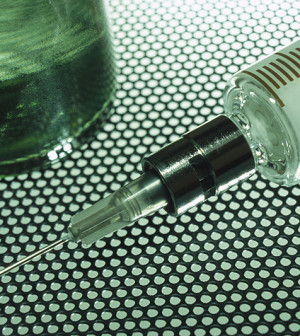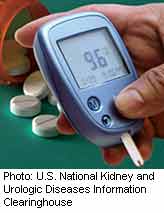- How Daily Prunes Can Influence Cholesterol and Inflammation
- When to Take B12 for Better Absorption and Energy
- Epsom Salts: Health Benefits and Uses
- See What Saffron Can Do for Sleep and Heart Health
- 6 Common Mistakes to Avoid Before Your Physical
- Can Sweating Really Help You Beat a Cold?
- Strengthening Your Relationship: Practical Strategies
- Skip Storing This Everyday Product in the Fridge Door
- Green Tea + B3 Pairing May Boost Brain Health
- Navigating Your Midlife Crisis: Embracing New Possibilities
Insulin Pump Shut-Off Feature Prevents Low Blood Sugar, Study Finds


TUESDAY, Sept. 24A new type of insulin pump reduced the number of moderate to severe low-blood-sugar episodes experienced by people with type 1 diabetes.
The pump has a special sensor that can detect dropping blood-sugar levels and then suspend insulin delivery to prevent the development of dangerously low blood sugar (hypoglycemia), according to the researchers.
“Hypoglycemia is a major problem in diabetes treatment,” said study senior author Dr. Timothy Jones, of Princess Margaret Hospital for Children in Perth, Australia. “The aim of the trial was to test whether a new type of insulin pump reduces life-threatening hypoglycemic events in patients with type 1 diabetes.”
“We found, in a randomized trial, that this technology was able to prevent severe hypoglycemia,” he said. “We don’t like to be dramatic, but this may save lives, and certainly will improve quality of life and diabetes control.”
The findings are published in the Sept. 25 issue of the Journal of the American Medical Association.
Type 1 diabetes is an autoimmune condition in which the body’s immune system mistakenly destroys the insulin-producing cells in the pancreas. Insulin is a hormone that helps usher blood sugar into the body’s cells to be used as fuel. Without insulin, blood-sugar levels rise and eventually reach life-threatening levels.
Since their bodies no longer produce insulin, people with type 1 diabetes must replace that lost insulin. To do this, they must either take multiple daily injections of insulin or use an insulin pump that has a tiny catheter inserted underneath the skin to deliver the insulin.
Getting the right amount of insulin can be difficult, however. People with diabetes have to factor in the amount of food they’ve eaten, their activity levels and many other factors that can affect blood sugar, and then figure out how much insulin they need.
If they get too much insulin, dangerously low blood-sugar levels can occur. Early symptoms of hypoglycemia can include shaking, sweating, confusion and a rapid heartbeat. If left untreated, hypoglycemia can cause seizures and even death, according to the American Diabetes Association. Too little insulin can cause high blood-sugar levels (hyperglycemia), which increases the risk of diabetes complications over time.
Currently, insulin pumps are completely user-driven. They do nothing automatically, other than deliver insulin. People with diabetes have to tell the pump how much insulin to deliver, or to stop insulin delivery when blood-sugar levels drop too low.
The new study looked at an insulin pump with a blood-sugar sensor and the capability to suspend insulin delivery if blood-sugar levels go too low. This device is already approved for use in Australia, where the study was conducted, Jones said. And, according to the website of the device’s manufacturer, Medtronic, it also has been approved in Europe and Canada, and has been submitted to the U.S. Food and Drug Administration for approval.
The new study compared 49 people on standard pump therapy to 46 people on the low-glucose insulin suspension pump. The study volunteers were between the ages of 4 and 50, and all had type 1 diabetes.
Before the start of the study, the people in the low-glucose insulin suspension group had about six times the rate of moderate to severe hypoglycemic episodes compared to those in the standard pump therapy group.
After six months, that trend almost reversed, and people in the standard insulin pump group had nearly four times as many hypoglycemic episodes as those with the low-glucose insulin suspension pump.
The study found no difference in levels of long-term blood-sugar control between the groups, and there were no serious episodes of high blood-sugar levels in either group.
“The major findings were that moderate and severe hypoglycemia was reduced significantly on the new treatment,” Jones said. “There were zero overnight convulsions in the group on the low-glucose suspend treatment, whereas the group on usual therapy continued to have events at the same rate as before.”
“New technologies will improve the treatment of diabetes and reduce the burden of care,” he said. “To reduce the fear of severe hypoglycemia would be a major advance, as would reduction in the frequency of major events. This would allow diabetics to get better control of their diabetes and improve their lives significantly.”
Dr. Rubina Heptulla, chief of the division of pediatric endocrinology and diabetes at the Children’s Hospital at Montefiore in New York City, said the low-glucose insulin suspend pump would help improve the quality of life for people with type 1 diabetes, and parents of children with type 1 diabetes.
“For some people, their [long-term blood-sugar levels] can never be brought down because they’re petrified of low blood sugar, especially during sleep,” she said. “If you’re deathly afraid of hypoglycemia, this type of pump may be a way to mitigate those fears. It’s a safety feature.”
Heptulla said she was surprised that the current study didn’t find a difference in long-term blood-sugar control for those on the low-glucose suspend system.
Both Jones and Heptulla said the low-glucose suspend pump is the first step on the path to an artificial pancreas, a device that experts hope will eventually be able to take over the control of diabetes management from patients.
More Information
Learn more about hypoglycemia from the American Diabetes Association.
Source: HealthDay
Copyright © 2026 HealthDay. All rights reserved.










